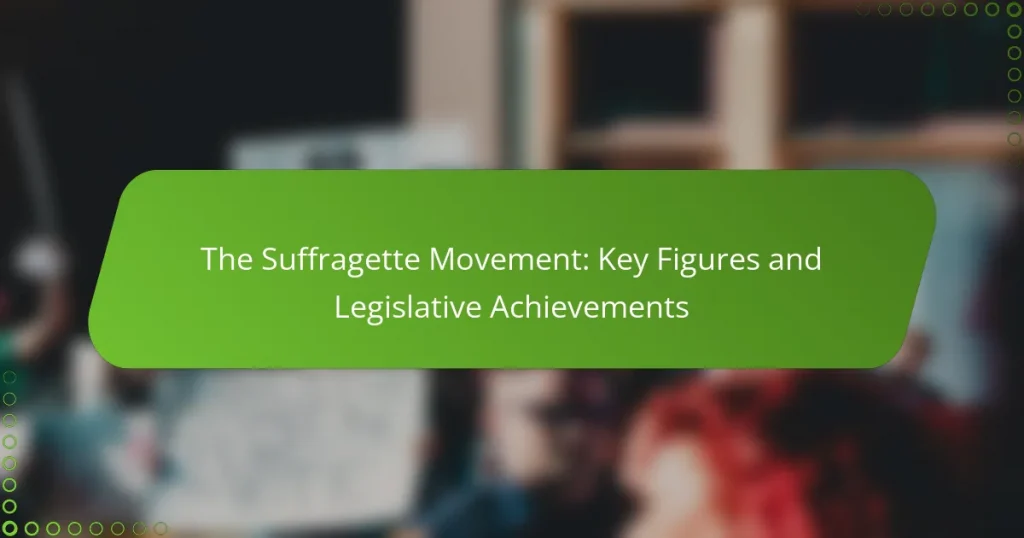The Suffragette Movement was a pivotal campaign advocating for women’s right to vote, emerging in the late 19th and early 20th centuries. Key figures such as Emmeline Pankhurst and Millicent Fawcett played significant roles in this movement, employing both militant tactics and peaceful protests to garner support. The movement led to landmark legislative changes, including the Representation of the People Act of 1918 in the UK, which granted voting rights to women over 30, followed by the extension of these rights to all women over 21 by 1928. Additionally, the ratification of the 19th Amendment in the United States in 1920 marked a significant achievement in the global fight for women’s suffrage. This article outlines the contributions of notable suffragettes and the legislative milestones that resulted from their relentless activism.

What was the Suffragette Movement?
The Suffragette Movement was a campaign advocating for women’s right to vote. It emerged in the late 19th and early 20th centuries. The movement was characterized by its militant tactics and civil disobedience. Key figures included Emmeline Pankhurst and her daughters, who founded the Women’s Social and Political Union in 1903. This organization organized protests, marches, and hunger strikes to draw attention to their cause. The movement led to significant legislative changes, including the Representation of the People Act in 1918 in the UK, which granted voting rights to women over 30. By 1928, this was extended to all women over 21, marking a pivotal victory for the movement.
How did the Suffragette Movement begin?
The Suffragette Movement began in the late 19th century as women sought the right to vote. It emerged from earlier women’s rights movements advocating for gender equality. Key events included the formation of the Women’s Social and Political Union (WSPU) in 1903 by Emmeline Pankhurst and her daughters. The WSPU adopted militant tactics to gain attention for their cause. Demonstrations, hunger strikes, and civil disobedience were common strategies. The movement gained momentum through increased public awareness and media coverage. By the early 20th century, suffragettes were recognized for their contributions to women’s rights. Their efforts ultimately led to significant legislative changes, including the Representation of the People Act 1918 in the UK.
What social and political conditions led to the Suffragette Movement?
The Suffragette Movement emerged due to a combination of social and political conditions. Industrialization led to increased employment opportunities for women. This shift changed societal perceptions of women’s roles. The rise of the middle class also contributed to demands for greater rights. Political disenfranchisement fueled frustration among women advocating for equality. The 19th century saw growing awareness of women’s rights through literature and activism. Significant events, such as the Seneca Falls Convention in 1848, inspired further action. Additionally, the influence of reform movements, like abolitionism, provided a framework for women’s rights activism. These conditions collectively ignited the Suffragette Movement, seeking voting rights and social reforms.
Who were the early advocates for women’s suffrage?
Early advocates for women’s suffrage included Susan B. Anthony, Elizabeth Cady Stanton, and Lucretia Mott. These women played pivotal roles in the suffrage movement during the 19th century. Susan B. Anthony co-founded the National Woman Suffrage Association in 1869. Elizabeth Cady Stanton organized the Seneca Falls Convention in 1848, which was the first women’s rights convention. Lucretia Mott was instrumental in promoting women’s rights and abolitionism. Their efforts laid the groundwork for future advancements in women’s voting rights in the United States.
What were the main goals of the Suffragette Movement?
The main goals of the Suffragette Movement were to secure voting rights for women. They aimed to challenge societal norms that restricted women’s participation in politics. Suffragettes sought legal recognition of women’s rights to vote in elections. Their activism included protests, demonstrations, and civil disobedience. The movement gained momentum in the late 19th and early 20th centuries. Key figures like Emmeline Pankhurst led these efforts. The movement ultimately contributed to the passage of legislation granting women the right to vote. In the UK, women over 30 gained the vote in 1918, and equal suffrage was achieved in 1928.
What specific rights were suffragettes fighting for?
Suffragettes were fighting for the right to vote in elections. They aimed to secure political equality for women. This movement sought to challenge the legal and societal barriers that denied women suffrage. The campaign included protests, marches, and civil disobedience. Key figures like Emmeline Pankhurst played crucial roles in mobilizing support. By 1918, the Representation of the People Act granted voting rights to women over 30 in the UK. This was a significant milestone in achieving gender equality in political representation. The suffragette movement laid the groundwork for future advancements in women’s rights.
How did the goals evolve over time?
The goals of the Suffragette Movement evolved from seeking basic voting rights to advocating for broader social reforms. Initially, suffragettes focused on gaining the right to vote for women in local and national elections. Over time, their goals expanded to include issues such as women’s education, employment rights, and social equality. The movement also shifted from peaceful protests to more militant actions as frustrations grew with slow legislative progress. By the early 20th century, suffragettes were not only fighting for the vote but also challenging societal norms regarding women’s roles. The passage of the Representation of the People Act in 1918 marked a significant milestone, granting voting rights to women over 30. This victory reflected the evolving goals of the movement, which had adapted to the changing political landscape and public sentiment. Ultimately, the suffragette movement laid the groundwork for future feminist movements, emphasizing the need for continued advocacy for women’s rights.

Who were the key figures in the Suffragette Movement?
Emmeline Pankhurst was a key figure in the Suffragette Movement. She founded the Women’s Social and Political Union in 1903. Pankhurst advocated for women’s right to vote through militant actions. Her leadership inspired many women to join the movement. Another significant figure was Millicent Fawcett. Fawcett led the National Union of Women’s Suffrage Societies. She promoted peaceful protest and lobbying for women’s suffrage. Other notable figures include Christabel Pankhurst and Annie Kenney. Christabel was known for her fiery speeches and activism. Kenney was instrumental in organizing protests and rallies. These individuals played crucial roles in advancing women’s rights in the early 20th century.
Who were the prominent leaders of the Suffragette Movement?
Emmeline Pankhurst, Millicent Fawcett, and Christabel Pankhurst were prominent leaders of the Suffragette Movement. Emmeline Pankhurst founded the Women’s Social and Political Union (WSPU) in 1903. She advocated for militant tactics to secure women’s voting rights. Millicent Fawcett led the National Union of Women’s Suffrage Societies (NUWSS). She promoted peaceful protests and negotiations for women’s suffrage. Christabel Pankhurst, Emmeline’s daughter, played a key role in the WSPU’s campaigns. These leaders significantly influenced the movement’s strategy and public perception. Their efforts contributed to the eventual granting of voting rights to women in the UK in 1918.
What contributions did Emmeline Pankhurst make?
Emmeline Pankhurst significantly advanced women’s suffrage in the United Kingdom. She founded the Women’s Social and Political Union (WSPU) in 1903. The WSPU utilized militant tactics to draw attention to the suffrage movement. Pankhurst organized numerous protests and hunger strikes to advocate for women’s voting rights. Her leadership inspired many women to join the cause. Pankhurst’s efforts contributed to the passing of the Representation of the People Act in 1918. This act granted voting rights to women over the age of 30. Her contributions were crucial in changing public perception and legislative action regarding women’s suffrage.
How did Millicent Fawcett differ in her approach?
Millicent Fawcett differed in her approach by advocating for women’s suffrage through peaceful and constitutional means. She focused on dialogue, persuasion, and political lobbying rather than militant actions. Fawcett led the National Union of Women’s Suffrage Societies (NUWSS), which emphasized organized campaigns and rational argumentation. She believed in working within the political system to achieve change. This contrasted with other suffragettes who employed more confrontational tactics. Fawcett’s strategy was to gain public support and influence lawmakers through reasoned discourse. Her efforts contributed significantly to the eventual success of women’s suffrage in the UK in 1918.
What roles did lesser-known figures play?
Lesser-known figures in the suffragette movement played crucial supportive roles. They organized grassroots campaigns and mobilized local communities. These individuals often worked behind the scenes, facilitating meetings and distributing literature. Many served as secretaries or treasurers for suffrage organizations. Their contributions included fundraising and coordinating events. They also engaged in activism through protests and demonstrations. Some lesser-known figures were instrumental in lobbying for legislative changes. Their collective efforts contributed significantly to the overall success of the movement.
Who were the grassroots activists within the movement?
Grassroots activists within the Suffragette Movement included women like Emmeline Pankhurst, Millicent Fawcett, and their supporters. Emmeline Pankhurst founded the Women’s Social and Political Union (WSPU) in 1903. Millicent Fawcett led the National Union of Women’s Suffrage Societies (NUWSS). These activists organized rallies, protests, and campaigns to demand voting rights for women. They faced significant opposition and often engaged in civil disobedience. Their efforts were crucial in raising awareness and mobilizing public support for women’s suffrage. The activism of these women directly contributed to the eventual passage of voting rights legislation.
How did women of different backgrounds contribute to the movement?
Women of different backgrounds significantly contributed to the suffragette movement through activism, leadership, and advocacy. African American women like Ida B. Wells highlighted racial injustices while fighting for voting rights. Native American women, such as Marie Louise Bottineau Baldwin, advocated for both indigenous rights and women’s suffrage. Immigrant women organized rallies and campaigns, bringing diverse perspectives to the movement. Working-class women played crucial roles in protests and strikes, emphasizing economic equality alongside suffrage. Each group brought unique challenges and goals, enriching the movement’s dialogue. Their combined efforts helped shape the broader fight for women’s rights in the United States.

What legislative achievements resulted from the Suffragette Movement?
The Suffragette Movement achieved significant legislative milestones, primarily women’s right to vote. In the United Kingdom, the Representation of the People Act 1918 granted voting rights to women over 30. This act marked a crucial turning point in electoral legislation. In the United States, the 19th Amendment was ratified in 1920, granting women the right to vote nationwide. These legislative changes were direct results of the persistent advocacy and activism of suffragettes. Their efforts included protests, hunger strikes, and lobbying, which raised public awareness and pressured lawmakers. The movement’s achievements laid the foundation for further advancements in women’s rights.
What key laws were passed due to the Suffragette Movement?
The Suffragette Movement led to the passage of key laws granting women the right to vote. The Representation of the People Act 1918 allowed women over 30 to vote in the UK. This act marked a significant shift towards gender equality in voting rights. In 1928, the Equal Franchise Act extended voting rights to all women over 21. These legislative achievements were direct results of the persistent efforts of suffragettes. Their activism raised awareness and pressured lawmakers to change discriminatory voting laws.
How did the Representation of the People Act 1918 change voting rights?
The Representation of the People Act 1918 significantly expanded voting rights in the UK. It granted suffrage to all men over the age of 21. It also gave the vote to women over the age of 30 who met minimum property requirements. This legislation marked the first time women could vote in parliamentary elections. Prior to this act, voting rights were largely restricted to property-owning men. The act enfranchised approximately 8.4 million women. It also created a more inclusive electoral system. This change was a crucial milestone in the suffragette movement’s efforts for gender equality in voting.
What impact did the 1928 Equal Franchise Act have?
The 1928 Equal Franchise Act granted equal voting rights to women in the UK. This legislation allowed women over the age of 21 to vote on the same terms as men. Prior to this, women had limited voting rights, primarily restricted to those who met certain property qualifications. The Act effectively enfranchised an additional 5 million women. It marked a significant milestone in the suffragette movement, fulfilling decades of activism and struggle. The passage of the Act symbolized the recognition of women’s equality in the political sphere. It also encouraged further advancements in women’s rights and representation in various sectors.
How did these legislative changes impact society?
Legislative changes from the suffragette movement significantly advanced women’s rights in society. These changes allowed women to vote and participate in political processes. The Representation of the People Act 1918 in the UK enfranchised women over the age of 30. This act marked a pivotal shift towards gender equality in political representation. In the United States, the 19th Amendment, ratified in 1920, granted women the right to vote nationwide. These legislative achievements empowered women, leading to increased participation in public life. Women’s voices began to shape policies and social issues. The impact of these changes fostered broader societal acceptance of women’s roles beyond traditional confines.
What were the immediate effects on women’s rights?
The immediate effects on women’s rights included the expansion of suffrage and increased legal recognition. Women gained the right to vote in several countries, notably in the United States with the 19th Amendment in 1920. This amendment legally granted women the same voting rights as men. Additionally, there was a rise in women’s participation in politics and public life. More women began to hold office and engage in civic activities. The movement also led to changes in social attitudes toward women’s roles. Society started to recognize women as equals in various spheres, including education and employment. These changes set the foundation for future advancements in gender equality.
How did these changes influence future movements for equality?
The changes from the Suffragette Movement significantly influenced future movements for equality. The successful advocacy for women’s voting rights set a precedent for other marginalized groups seeking equality. It demonstrated the effectiveness of organized activism and civil disobedience. The movement’s strategies inspired subsequent civil rights movements in the 20th century. For instance, the Civil Rights Movement in the United States drew on similar tactics of protest and legal challenges. Furthermore, the suffragettes’ achievements highlighted the importance of legislative change in advancing social justice. Their legacy continues to motivate contemporary movements advocating for gender equality and broader human rights.
What lessons can we learn from the Suffragette Movement today?
The Suffragette Movement teaches us the importance of perseverance in the face of adversity. Activists like Emmeline Pankhurst faced significant opposition yet continued to advocate for women’s rights. Their efforts led to the eventual passage of the Representation of the People Act in 1918, granting voting rights to women over 30 in the UK. This highlights the impact of organized activism on legislative change. The movement also underscores the value of solidarity among marginalized groups. Women united across various social classes to push for equality. Additionally, it illustrates the necessity of strategic communication and public engagement. The suffragettes effectively used protests and media to raise awareness and gain support. Today, these lessons can inform contemporary movements for social justice and equality.
The Suffragette Movement was a pivotal campaign advocating for women’s right to vote, emerging in the late 19th and early 20th centuries through militant tactics and civil disobedience. Key figures such as Emmeline Pankhurst and Millicent Fawcett played significant roles in organizing protests and lobbying for legislative changes, leading to milestones like the Representation of the People Act 1918 in the UK and the 19th Amendment in the US. The movement’s goals evolved from seeking basic voting rights to advocating for broader social reforms, highlighting the contributions of diverse women and grassroots activists. The legislative achievements of the Suffragette Movement not only transformed political representation but also laid the groundwork for future equality movements, emphasizing the importance of organized activism and solidarity in the pursuit of social justice.




